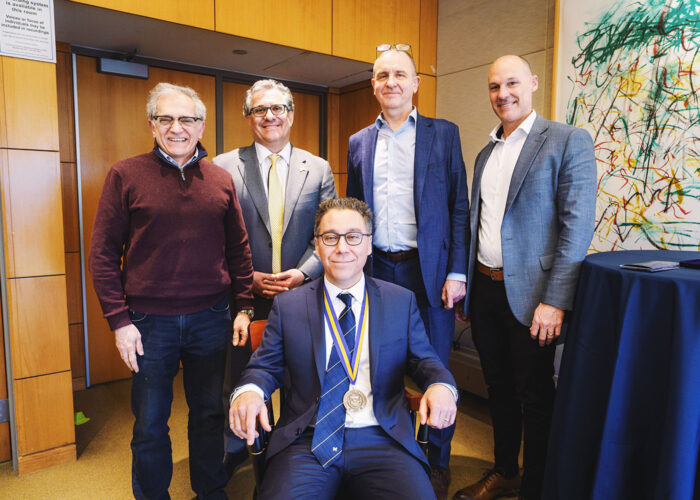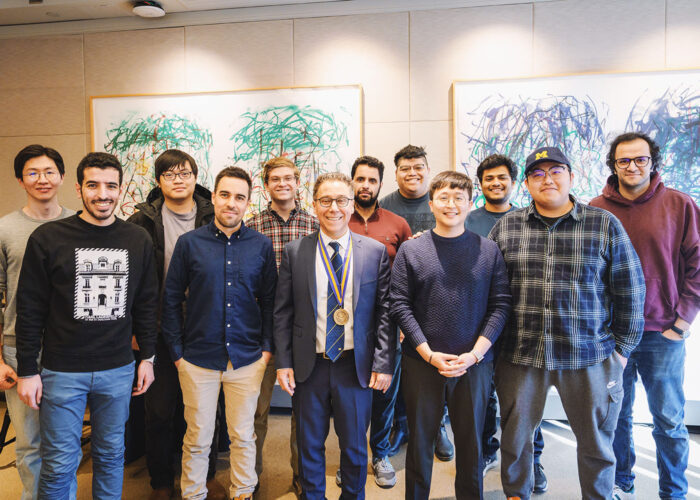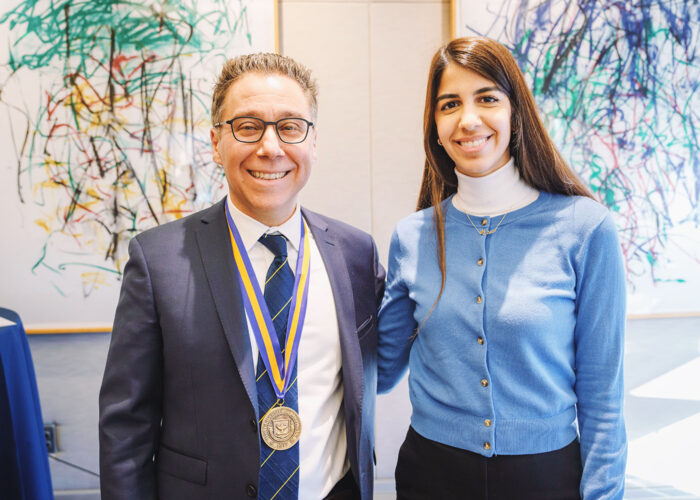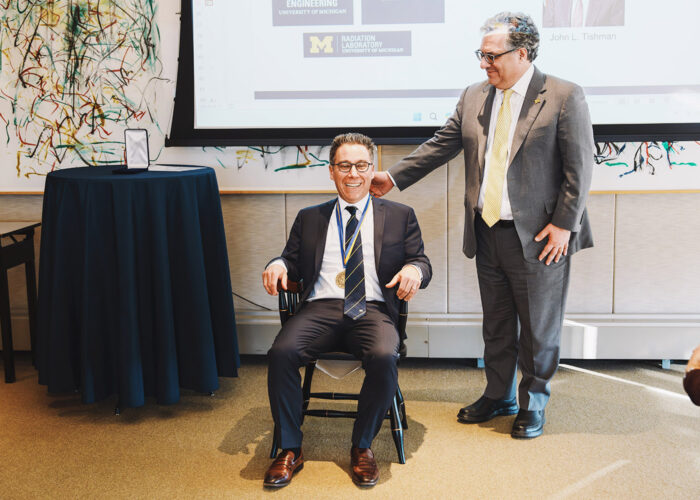Anthony Grbic named John L. Tishman Professor of Engineering
Anthony Grbic has been named the John L. Tishman Professor of Engineering in recognition of his outstanding contributions in the areas of research, education, and leadership.
Grbic is a world leader in the development of metamaterials and metasurfaces, which are engineered materials and surfaces whose fine textures dictate their unusual electromagnetic properties. His pioneering research has led to ultra-thin electromagnetic and optical devices with unprecedented capabilities, and to the development of new opportunities in low-profile antennas, lenses and ultrathin 3D holographic platforms. His work has been foundational for achieving unusual phenomena such as near-field, lens-free focusing, understanding electromagnetic structures whose properties vary in both space and time, and more.
Grbic is credited with being the first to create a metamaterial superlens that surpassed the resolution limitations of conventional lenses, and he helped develop circuit-based metamaterials resulting in transformative electromagnetic devices. He co-invented (with Prof. Roberto Merlin, the Peter A. Franken Collegiate Professor of Physics) near-field plates, surfaces that can confine electromagnetic energy to extreme subwavelength resolutions, an innovation that can allow lithographic systems with unparalleled resolution and improvements in the range and efficiency of wireless power transfer systems.
He was the first to create high efficiency, reflectionless metasurfaces, known today as Huygens’ metasurfaces, and introduced a pragmatic approach to developing bianisotropic metasurfaces, which are allowing thinner optical and quasi-optical components and flat-panel antenna systems that could replace dishes and reflector-based systems.
Over the past five years, as part of a Multidisciplinary University Research Initiative led by The City University of New York, he has been developing time-varying metamaterials whose properties can vary both in space and time, resulting in more efficient and cost-effective ways to transmit and receive electromagnetic waves. The work has applications in next-generation wireless communication, commercial and military radar systems, imaging, and antenna systems.
Grbic is a gifted educator, which was acknowledged when he received the U-M Henry Russel Award. In addition to developing the graduate course Electromagnetic Metamaterials, he revived EECS 435 (Fourier Optics), and significantly revised EECS 531 (Antenna Theory and Design) and the major design experience course EECS 430 (Wireless Link Design) – a course that has been voted one of HKN’s favorite courses.
Grbic regularly engages undergraduates students in his research, and his graduate students (some of whom started out as UG students on his team) have received numerous honors and awards, including best paper awards, U-M and NSF fellowships, and selection for participation in the MIT Rising Stars in EECS Workshop. He also has mentored several postdoctoral researchers.
He is currently in his second year of service as a Microwave Theory and Techniques Society (MTT-S) Distinguished Microwave Lecturer.
Grbic has regularly served as graduate advisor for Applied Electromagnetics and RF Circuits, and has also served on several committees focused on undergraduate students. He is currently the Senior Associate Chair for ECE.
In addition to the awards already mentioned, Grbic has received the David E. Liddle Research Excellence Award, U-M Faculty Recognition Award, and he was the first recipient of the Ernest and Bettine Kuh Distinguished Faculty Award at U-M. He has also been honored with the MTT-S Outstanding Young Engineer Award, USNC/URSI Booker Fellowship, AFOSR Young Investigator Award, NSF CAREER Award, and Presidential Early Career Award for Scientists and Engineers (PECASE), which is the highest honor bestowed by the U.S. government on scientists and engineers beginning their independent careers. He is an IEEE Fellow.
About John L. Tishman
John L. Tishman (BSE EE 1946) was the former chair and CEO of Tishman Realty & Construction Corporation. After graduating from U-M, he served as an officer in the U.S. Navy, and was a teacher at the Walden School in New York City before beginning his career with the Tishman organization in 1948.
Mr. Tishman was the prime mover in advancing modern building technology and techniques at the family firm. Tishman Research, the only such operation within an American construction firm, was founded under his direction in 1959. Many products and techniques initiated by Tishman Research are now staples of the building trades, such as dry shaft-wall construction; new facade techniques, which reduced weight, lowered costs, and allowed use of ultra-thin stone veneers; a body-heat activated “smart lighting system”; and many energy-conserving and environmentally friendly building operating and design techniques.
Mr. Tishman was personally responsible for such landmark Tishman commissions as the World Trade Center in New York, the John Hancock Center in Chicago, the Renaissance Center in Detroit, Walt Disney Company’s EPCOT Center in Florida, and the renovation and restoration of Carnegie Hall in New York City.
Beyond Mr. Tishman’s professional achievements, he was a leader in humanitarian and educational endeavors, serving on the boards of Ronald McDonald House, New York University Medical Center, Carnegie Hall, and the New School University, including its Mannes College of Music and Parsons School of Design.
Photos from the event
.
 MENU
MENU 





